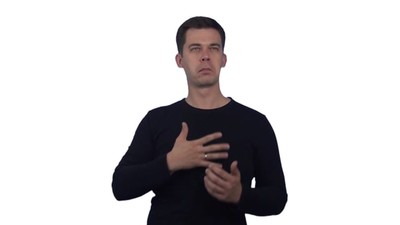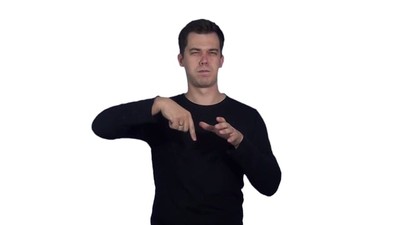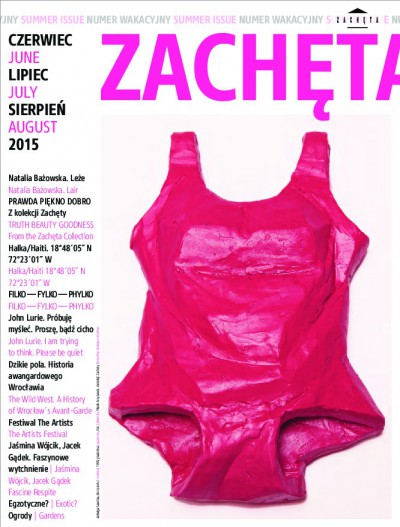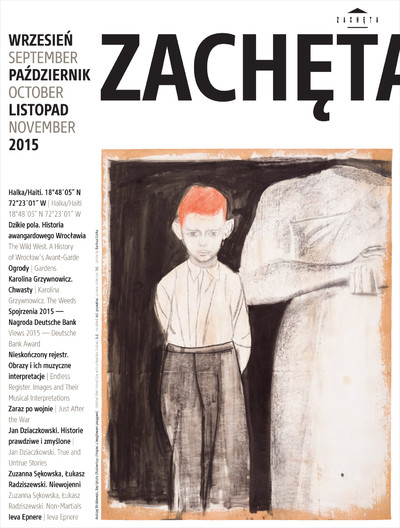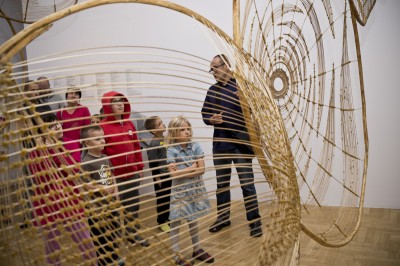Thinking about the exhibition, which can be enjoyed regardless of sense impairments, it is worth considering what it means to ‘see’ a work of art. What is the role of the different senses in the perception of reality, and the reality created by artists? Vision has always had a privileged position in the process of cognition. To see means as much as knowing, but also understanding and believing. Vision still plays a major role in art — this applies in particular to contemporary art in the 21st century, dominated as it is by digital media. No matter how much we would like to open up to other type of experience, there is no way diminish its role. But to what extent does vision limit us in our contact with art?
The Gardens exhibition abolishes the principle of ‘do not touch’ and reduces the physical distance between the viewer and the art. In the reception of paintings, installations, and objects exhibited here, vision is equally as helpful as hearing, smell, touch, taste, and a sense of movement. Materiality and sensuality lies at their essence. Visitors are encouraged to touch, both visually, as well as with their hands, smell, listen, tread on the art and climb on it — in accordance, of course, with the ‘instruction manual’ prepared by the artists. Invited artists use materials clearly associated with nature: sand, rocks, peat, beeswax, grass, wicker, live plants, branches, and mushrooms. Their installations have size, weight and volume, they generate sounds and emit odours. In a sense, the exhibition draws on the experience of sensory gardens, designed to deliberately stimulate all of the senses. It resembles an invitation to a secret garden — a garden with hidden secrets, meandering memories and delights, a labyrinth between the real and the metaphor, a garden suspended between the worlds of emotion and reason.
Magdalena Godlewska-Siwerska
artists:
Paweł Matyszewski: a graduate of the Academy of Fine Arts in Poznań (diploma in 2009 in Piotr C. Kowalski’s studio), in 2014 he was a PhD student at the University of Arts in Poznan.
Mirosław Maszlanko: a graduate of the Faculty of Painting at the Academy of Fine Arts in Warsaw (diploma in Stefan Gierowski’s studio, annex in sculpture under the supervision of Adam Myjak). A sculptor and creator of land art.
Marzanna Morozewicz: creates paintings, painting objects, textiles, drawings, and photographs. Works at the University of Białystok.
Małgorzata Niedzielko: a graduate of the Faculty of Sculpture at the Academy of Fine Arts in Warsaw (diploma in 1989 in the studio of Grzegorz Kowalski). A sculptor, author of objects and installations. She engages in social and educational activities, and since 2005 has run her own sculpture studio at the Visual Arts Secondary School in Supraśl.
Anna Panek: a graduate of the Faculty of Architecture at Wrocław University of Technology and the Faculty of Painting at the Academy of Fine Arts in Warsaw (diploma in Leon Tarasewicz’s studio, annex in Grzegorz Kowalski’s studio), she works at the Academy of Fine Arts in Warsaw. Creates large-surface paintings that fit within existing architecture.
Igor Przybylski: a graduate of the Faculty of Painting at the Academy of Fine Arts in Warsaw (diploma in Jarosław Modzelewski’s studio), and a research worker at the Academy of Fine Arts in Warsaw. Creator of photographs, paintings, and videos.
Iza Tarasewicz: a graduate of the Faculty of Sculpture and Spatial Activities of the Academy of Fine Arts in Poznan. Creates sculptures, installations, photographs, drawings, and performances.
Krzysztof Topolski: a multimedia artist, performer, musician, composer and curator of art projects. In his sound compositions he uses computer-processed sounds, as well as sounds collected from nature and urban environments. Also creates interactive sound installations.
Zenek (Iłarion Daniluk) (1939–2000): lived and worked in the Podlasie region of Poland. A self-taught painter, his paintings adorn houses and flats, mainly in Hajnówka and the surrounding area. Zenek used floral motifs to cover everything: walls, staircases, clothes hangers, radiators, even the insides of bed frames. He was an idyllic painter, and in his work he presented a colourful and prosperous world, which embodied dreams of prosperity in Poland in the 1970s and 1980s. The joy of painting present in his works and their expression recall associations with works by Douanier Rousseau and Antoni Ociepka. Zenek’s art has become widely known thanks to documentaries and popularisation efforts by Jan Gryka.


